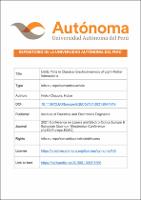Dalitz Plots in Classical Electrodynamics of Light-Matter Interactions
Publisher
Institute of Electrical and Electronics Engineers
Journal
2021 Conference on Lasers and Electro-Optics Europe & European Quantum Electronics Conference (CLEO/Europe-EQEC)
Additional Links
https://www.scopus.com/inward/record.uri?eid=2-s2.0-85117591736&doi=10.1109%2fCLEO%2fEurope-EQEC52157.2021.9541819Abstract
One of the most prominent techniques to search for new resonances and masses of elementary and composed particles is called the Dalitz’s plot [1][2]. The technique is used on the decays of up to three bodies. In this manner, one can wonder about the usefulness of Dalitz’s plot in classical electrodynamics if in principle classic physics cannot make a solid conceptualization on the existence of resonances. Subsequently emerges another question: What is the classical analogue of a quantum mechanics resonance? Although mathematically one can argue a certain similarity in the formalism and models, in order to claim a type of similarity between the quantum mechanics and classical electrodynamics, clearly a solid claim necessitates to expose a realization of resonances that fits a experimental observation. Experimental Usage of Dalitz’s Plots Normally in Particle Physics, for example the case of light-matter interaction one aims the reconstruction of primary particles through the gathered data that serves to reconstruct the physics properties such as momentum and energy. For example, considers the channel $\gamma + \gamma \Rightarrow {\tilde X^ + } + {\tilde Z^ - }\;{\text{with}}\;\tilde X$ an unstable particle decaying as ${\tilde X^ + } \Rightarrow {{\text{X}}_1} + {{\text{X}}_2} + {{\text{X}}_3}$. Once all X 1,2,3 are reconstructed, it is feasible to conjugate all of them in a scenario of invariant mass given by the following expressions that requires the knowledge of all involved energy and momentum: ${M_{1,2}} = \sqrt {{{\left( {{E_1} + {E_2}} \right)}^2} + {{\left( {{{\mathbf{p}}_1} + {{\mathbf{p}}_2}} \right)}^2}} ,{M_{2,3}} = \sqrt {{{\left( {{E_2} + {E_3}} \right)}^2} + {{\left( {{{\mathbf{p}}_2} + {{\mathbf{p}}_3}} \right)}^2}} $. In praxis, one employs the technique of 2-D histograms to construct M 1,2 versus M 2,3 plots by which the accumulation of superimposed events would give a signal of existence of any resonance or mass of primary particle [3]. Dalitz’s Plots in Classical Nonlinear Compton Scattering: One of the notable application of classical electrodynamics to compare to its quantum mechanics counterpart, is the theory of classical Compton scattering done by Hartemann and Kerman [4]. They have derived and numerically shown that the classical analogue of Compton scattering has the closed-form written as:\begin{equation*}\frac{{{d^2}I(\omega , - z)}}{{d\omega d\Omega }} = \frac{{{e^2}}}{{4{\pi ^2}}}u_0^2{\chi ^2} \times {\left| {\int_{ - \infty }^{ + \infty } {{A_x}} (\phi )\exp \left\{ {i\chi \left[ {\phi + \int_{ - \infty }^{\phi '} {{{\mathbf{A}}^2}} (\psi )d\psi } \right]d\phi } \right\}} \right|^2}.\tag{1}\end{equation*}
Type
info:eu-repo/semantics/article
Rights
info:eu-repo/semantics/restrictedAccess
Language
eng
Collections
- Ingeniería de Sistemas [332]


